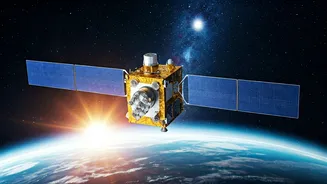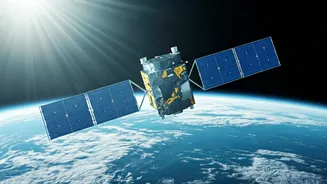Drishti's Groundbreaking Debut
GalaxEye's Mission Drishti, projected for launch in 2026, is poised to make history. This ambitious project is not just another satellite; it's the world's
first multi-sensor EO satellite, representing a significant technological advancement. Weighing in at 160 kg, Drishti is a testament to India's growing prowess in the space-tech sector. The satellite's multi-sensor capabilities are designed to capture a comprehensive range of data about Earth's surface, providing detailed insights for various applications. This innovative approach sets Drishti apart, promising unprecedented levels of precision in Earth observation and data collection. The satellite is designed to have very high resolution, allowing for much clearer and more detailed imagery of the Earth than currently available.
India's Private Space Triumph
The creation of Mission Drishti marks a watershed moment for India's private space industry. As the largest privately-built satellite in the country, it signifies the growing involvement of private companies in space exploration and technology development. This shift not only fosters innovation but also accelerates the pace of advancements in the field. Drishti’s development showcases the potential of private-public partnerships in furthering India's space program, pushing the boundaries of what's achievable. The fact that it is the highest-resolution satellite developed in India further underscores the remarkable capabilities being cultivated within the nation's private sector, setting a new benchmark for future space endeavors. This could lead to future advances in agriculture, environmental monitoring, and urban planning, among many other fields.
Multi-Sensor EO Technology
At the heart of Drishti’s groundbreaking potential is its multi-sensor technology. The integration of various sensors allows the satellite to gather a diverse range of data, going beyond the capabilities of conventional satellites. By combining different types of sensors, Drishti can capture a holistic view of Earth, providing valuable information for various applications. This advanced approach will enable the satellite to observe the planet in unprecedented detail, generating comprehensive datasets essential for environmental monitoring, disaster management, and urban planning. Drishti’s multi-sensor capabilities represent a significant leap forward in EO, offering the potential to revolutionize how we understand and manage our planet. It is also important to note that the data will contribute to improved resource management and climate change studies.
High-Resolution Capabilities
A key feature of Drishti is its exceptional high-resolution imaging. This attribute positions the satellite as a leader in Earth observation technology. The ability to capture extremely detailed images allows for a deeper analysis of the Earth's surface, enabling scientists and researchers to discern intricate details that were previously unobtainable. High-resolution imagery is invaluable for mapping, monitoring, and tracking environmental changes, aiding in everything from urban planning to disaster response. Drishti's advanced resolution will empower users to obtain richer insights and conduct a more thorough analysis of Earth's conditions, promoting more efficient decision-making. This high resolution will likely be leveraged for border security applications as well.
A 2026 Launch Anticipated
The planned launch year of 2026 signifies the culmination of GalaxEye's efforts and the beginning of a new era in Indian space technology. The launch of Drishti will be a significant milestone, representing the hard work and dedication of the team involved. This event will be closely monitored by the space community, marking the arrival of the world's first multi-sensor EO satellite. With the launch scheduled, all eyes are on GalaxEye, and anticipation builds as Drishti prepares to take its place in orbit. The launch is expected to further validate the company's capabilities and highlight India's growing prowess in the global space market. The launch will provide significant opportunities for the Indian Space Research Organisation as well.

















